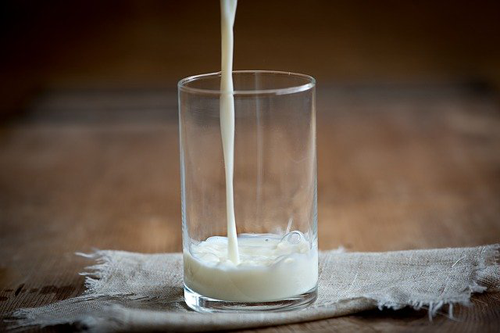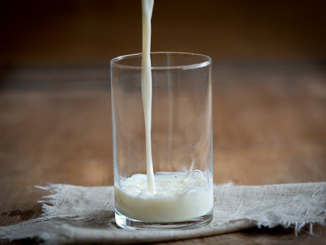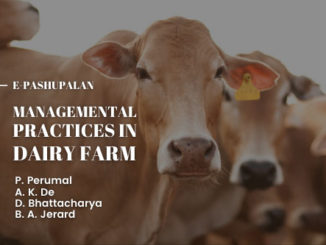Abstract
Milk is the complete food. It contains in a balanced form of all the necessary and digestable elements for building and maintaining the human and animal body. In addition, it contains immunoglobulins which protect the newly born against a number of diseases’. Generally, milk is the substitute for human milk. Research has shown that milk and milk products have an immune enhancing properties as well, particularly f0r the benefit of HIV/AIDS affected people. Generally, animals’ are milked at least twice a day worldwide including India, which can influence hygiene quality of milk considerably.
Key words: Hygiene, Milk, Milk Products, Pasteurization.
Milk: Milk may be defined as the whole, fresh, clean, lacteal secretion obtained by the complete milking of one or more healthy milch animals, excluding that obtained within 15 days before or 05 days after calving or such periods as may be necessary to render the milk practically colostrum-free, and containing the minimum prescribed percentages of milk fat and milk-solids-not-fat.

Hygiene: Hygiene is defined as conditions or practices conducive to maintaining health and preventing disease, especially through cleanliness.
The sanitation of the milk supply can be safeguarded in two ways
Production and handling of raw milk in such a manner as to prevent its contamination by pathogenic organisms. This will require :
- Ensuring the health of dairy cattle by various control measures.
- Safeguarding the health of employees by regular medical examination.
- Protection of the water supply from contamination by pathogenic organisms.
- Flies and their control. Example – Certified Milk, Grade A Raw Milk.
Pasteurization of milk, so as to kill all pathogenic organisms and avoidance of any post-pasteurization contamination.
Pasteurization: The term pasteurization has been coined after the name of Louis Pasteur of France, 1860-64.
Definition: It is the process of heating every particle of milk to at least 63ºC (145ºF) for 30 minutes or 72ºC (161ºF) for 15 seconds. After pasteurization, the milk is immediately cooled at 5ºC (41ºF) or below.
Objectives
- To render milk safe for human consumption by destruction of percent pathogenic micro-organisms.
- To improve the keeping quality of milk by destructionof almost all spoilage organisms (85-99%).
- Pasteurization encourages slackening of efforts for sanitary milk production.
- It may be used to mask low-quality milk.
- It diminishes significantly the nutritive value of milk.
- It reduces the “cream line” or “cream volume”.
- Pasteurized milk will not clot with rennet.
- Pasteurization may be carelessly done ; it gives a false sense of security.
- It fails to destroy bacterial toxins in milk.
- In India pasteurization is not necessary, as milk is invariably boiled on receipt by the consumer.
Types of pasteurization
- LTLT (Low-Temperature-Long-Time) method or batch/holding pasteurization: 63ºC/145ºF for 30 minutes and cooled to 5ºC or below.
- HTST (High Temperature Short Time): 72ºC/161ºF for 15 seconds and cooled to 5ºC or below. First developed by A.P.V. Co. in the UK in year 1922.
Diseases which are known to be transmissible through milk are listed as, together with the manner in which they may enter the milk :
- Infection of milk directly from the cow: For Example – Bovine Tuberculosis, Undulant Fever or Malta Fever etc.
- Infection from man to cow and then to milk: For Example – Septic sore throat, Scarlet fever, Diptheria etc.
- Direct contamination of milk by human beings: For Example – Gastroenteritis, septic sore throat, scarlet fever, Typhoid fever, Parathyroid fever, Dysentery, Diptheria etc.
- Indirect contamination of milk by human beings: For Example – Typhoid or Parathyroid fever, Dysentry or Diarrhoea etc.
Cleaning Equipment
- Rinsing in clean water.
- Scrubbing in hot.
- Apply on the detergent/disinfectant solution.
- Finally rinsing in chlorinated (50 ppm) water.
- Drain dry in a clean place.
Sources of contamination of milk and their control
|
Sources Of Contamination |
Control Measures |
| Interior of the udder |
|
| Exterior of the cow, particularly udder and flanks |
|
| Barn air and dust |
|
| Flies and other vermin |
|
| The Milker |
|
| Utensils |
|
Quality control tests for milk
- Dye-reduction test (MBR or Resazurin) – To determine the extent of bacterial contamination and growth in milk.
- DMC (Direct microscopic count) – To identify the types of micro-organisms present in milk.
- SPC (Standard plate count) – to determine the extent of bacterial contamination and growth in milk.
Conclusion(s): Few Principal Rules along with Prevention of contamination must be followed by farmer/dairy farmer/dairy entrepreneur in their dairy farm(s) –
Principle Rules
- Good husbandry practices.
- To keep a bacterial count of less than 50,000 per ml.
- One infected quarter may result in the milk from the whole herd being unacceptable.
- Simple practices can reduce the infection at udder.
Prevention of contamination
- Keep udder clean as possible.
- Any visible dirt must be removed using clean, running water, individual paper, towels or clothes in clean water.
- Adding disinfection water with sodium hypochlorite at 300 ppm.
- A clean cloth for each cow.






1 Trackback / Pingback